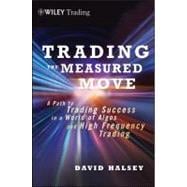
Note: Supplemental materials are not guaranteed with Rental or Used book purchases.
Purchase Benefits
What is included with this book?
DAVID HALSEY is founder of the website EminiAddict.com, which provides trader education and market commentary. His focus is day trading and swing trading stock index futures utilizing techniques designed to stay on the right side of institutional order flow and identify short-term setups. Halsey provides a daily market analysis, predictions, and an interactive forum for his subscribers. His videos are utilized by several brokerage firms and disseminated to their clients.
Preface
This Book’s Target Audience
Fibs Make the Moves
Acknowledgments
Chapter 1 Today’s Trading Environment
Descent of the Pit and Ascent of the Screen
Players on the Field
The Algo Brothers
Where Are You?
Chapter 2 Inside the Hidden Market
Deep Roots
Beyond 1.618
Fibonacci Basics
Fibs Make the Moves
Why Do Fibs Work?
Fibs in the Real World
In Summary
Chapter 3 Drawing a Road Map
Finding Direction
A Mountain Range of Price
Obstacles in the Road: Pivot Points
Navigating Trends
Long and Winding Roads
Chapter 4 More Tools for Trading Power
Filling the Toolbox
Watching the Clock (and the Calendar)
Tick Tock
The Tape and the DOM
The DOM (Depth of Market)
A Full Toolkit
Chapter 5 The 90% Factor - Executing Your Trade
Where the Rubber Meets the Road
Priorities and Job One
What’s the Risk, What’s the Reward?
A Brief Pit Stop
Preparing the DOM
Crossing the Starting Line
Running Off the Road
When Multiple Contracts Just Aren’t Possible
Why 90%?
Chapter 6 Three Types of Trade Setups
The Traditional 50% Measured Move
A Series of Measured Moves
Which Traditional Measured Moves Not to Trust
The Extension 50% Measured Move
The Extension 50% in a Series
Which Extensions Not to Trust
The 61.8% Failure
What 61.8% Failures Not to Trust
The Order of the Trade
Chapter 7 Using Multiple Timeframes to Trade
Timeframes and Russian Dolls
The Path of Least Resistance
Trading the Trend
Why Do Markets Continue to Make New Highs?
Why Do Markets Continue to Make New Lows?
A New Concept
What Timeframe Should We Look At?
Types of Multiple Timeframes
The Weekly Trend
The Daily Measured Moves
The 15 Minute Trend
The Micro Trend
Why Is This Important to Your Trading?
Chapter 8 Three Entry Strategies for Retracements
The Goal
Front Runs and First Targets
The Three Entry Strategies
The First Test
How to Trade a First Test
The Front Run of the Second Test
How to Trade the Front Run of the Second Test
The Trend Break and Next Measured Move
How to Trade the Trend Break
The Progression of Entries
Why Is This Important to Your Trading?
Chapter 9 The Seasonality of Markets and the Best Times to Trade
The Big Picture
The Months
Studying the Past
A Money Manager’s Year
The Summer
The Fall
The Winter and Spring
The Days
The Hours (The Best and Worst Times to Trade)
The Worst Times to Trade
The Typical Money Manager
Why Is This Important to Your Trading?
Chapter 10 Tools for the NYSE
Lagging versus Leading Indicators
Tools for the NYSE
Bank
How to Use Bank
Breadth
How to Use Breadth
The Tick
Tick Hooks
Time and Sales
How to Trade Time and Sales
Trade the Trend
Using All the Tools Together
Chapter 11 Tick Extremes and Divergences
The Types of Tick Extremes
The Old Way
The New Way
Ticks That Signal a Reversal
Tick Divergences
How to Use a Divergence
What Happens If the Trend Breaks?
Why Is This Important to Your Trading?
Chapter 12 Profiting from Gap Fills
What Is a Gap?
In What Instruments Do Gap Fills Exist?
The Types of Gap Fill Scenarios
Gap Fills to Avoid
Options Expiration Fridays
Rollover Thursday and the Day After
The First Trading Day of the New Quarter
10 Point Gap-and-go Levels
No Trade Zones
Gap Fill Percentages
Tools for the Gap Fill
The Traditional Trader’s Way
The Conservative Way
The Gap Fill Workflow and Filter
Entries
Which Entry?
When Gaps Don’t Fill
What to Do?
Why Is This Important to Your Trading?
Chapter 13 How to Manage Positions and Take Profits
The Rule for Measured Moves
The Distance Formula
Trailing a Series of Measured Moves
After the Confirmation of Trend
Using the -23% Profit Target: Take Profit on the Time Frame You Entered the Trade
Why Is This Important to Your Trading?
Chapter 14 Risk Management (Advanced Trade Management)
Bob the Trader
Curtis the Contractor
Risk per Trade
How Many Futures Contracts Should I Trade?
Stop Placement
The Free Trade
The Reduced Risk Trade
Why Scale Out?
Pick an Instrument and Focus on It
Trading the News Is Gambling
Chapter 15 The Inner Trader
The Emotions of a Trader
Mentality
Money Management
Emotions
How Long Does it Take for a New Trader to Trade Well?
Attitude
Are You Proactive or Reactive?
Trading Well versus Trading for Profit and Emotional Capital
Chapter 16 The Trading Plan
Keeping Yourself Safe with Statistic-Based Rules
The Four Legs of a Trading Strategy
Leg 1: Money Management
Leg 2: Entry Rules
Leg 3: Profit Taking Rules
Leg 4: Statistical Based Trading Rules
Why Trading Rules
General Trading Account Rules
Gap Fill Trading Rules
American (NYSE) Session Trading Rules
European (Euro) Session Trading Rules
Setups
Daily Setups
15 Minute Setups
Micro Setups
About the Author
Index
The New copy of this book will include any supplemental materials advertised. Please check the title of the book to determine if it should include any access cards, study guides, lab manuals, CDs, etc.
The Used, Rental and eBook copies of this book are not guaranteed to include any supplemental materials. Typically, only the book itself is included. This is true even if the title states it includes any access cards, study guides, lab manuals, CDs, etc.